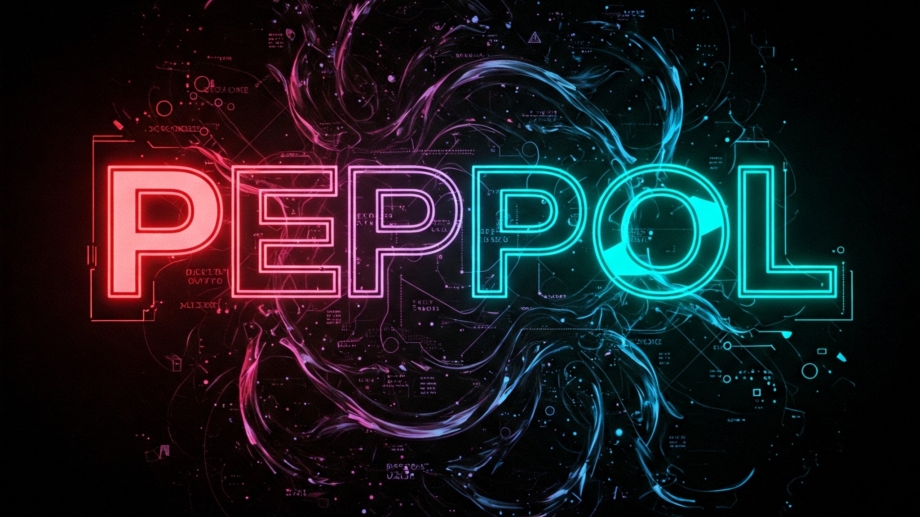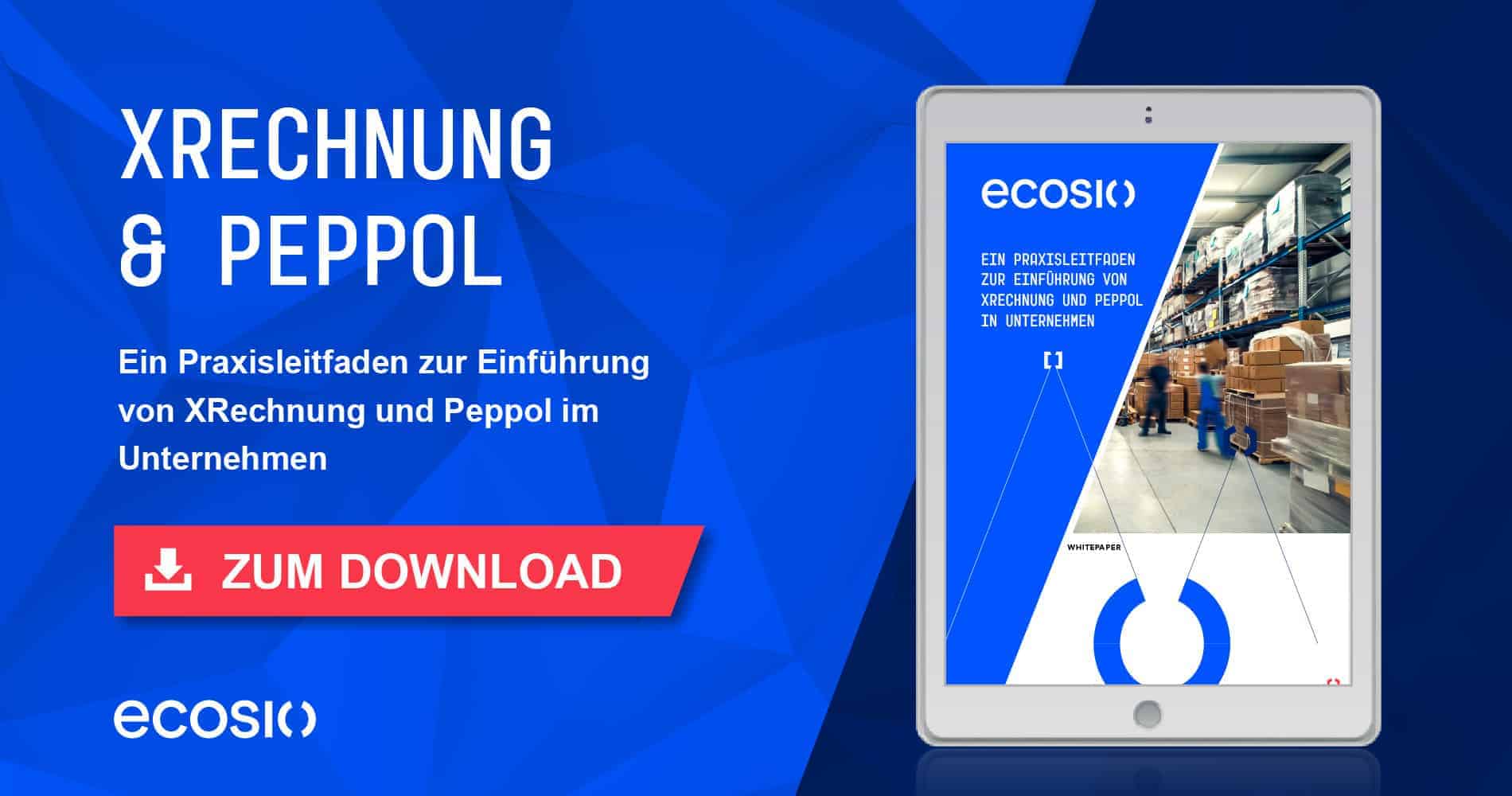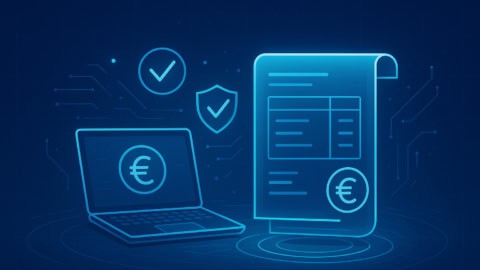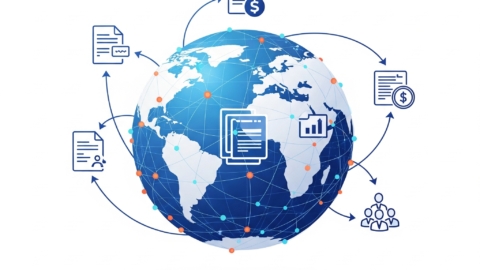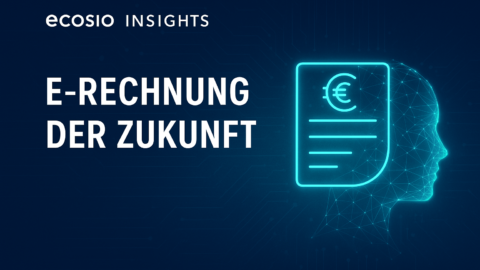Klicken Sie hier um die Video-Abschrift zu lesen
Immer mehr Länder setzen auf die E-Rechnung – besonders im öffentlichen Sektor. Der Peppol Access Point ist dabei das zentrale Element für den sicheren, standardisierten Austausch elektronischer Geschäftsdokumente. Ob Rechnung oder Bestellung – mit Peppol können Unternehmen weltweit schneller, günstiger und gesetzeskonform kommunizieren.
Was ist Peppol?
Peppol steht für „Pan-European Public Procurement Online“. Es handelt sich nicht um eine Plattform, sondern um ein standardisiertes Netzwerk, das den sicheren Austausch elektronischer Dokumente zwischen Unternehmen und Behörden ermöglicht – länderübergreifend und rechtskonform.
Warum Peppol?
-
Einheitlicher Standard weltweit
Peppol ermöglicht den strukturierten, internationalen Austausch von E-Rechnungen ohne länderspezifische Anpassungen. -
Kostensenkung durch reduzierte Komplexität
Einmal angebunden, erreichen Sie alle Partner – ohne individuelle Schnittstellen oder Formate. -
Höhere Effizienz und Geschwindigkeit
Automatisierte Prozesse minimieren manuelle Schritte und beschleunigen den Dokumentenaustausch erheblich. -
Sichere Kommunikation durch zertifizierte Access Points
Der Austausch erfolgt verschlüsselt und über geprüfte Anbieter – für maximale Datenintegrität und Compliance.
Was sind die 3 Säulen von Peppol?
Was Peppol bietet, lässt sich letztlich auf drei Faktoren zusammenfassen, die als die drei Säulen von Peppol bekannt sind. Diese sind:
-
Peppol-Netzwerk
Das technische Rückgrat für den sicheren, standardisierten Austausch elektronischer Dokumente. -
Peppol-Dokumentenspezifikationen (Peppol BIS)
Einheitliche Vorlagen und Formate für E-Rechnungen, Bestellungen und andere Geschäftsdokumente. -
Peppol-Vereinbarungsrahmen (TIA)
Rechtliche und technische Regeln, die eine zuverlässige Zusammenarbeit aller Teilnehmer sicherstellen.
Was braucht man für den Anschluss an Peppol?
Um sich mit dem Peppol-Netzwerk zu verbinden, benötigt ein Unternehmen lediglich die Fähigkeit, automatisierte Nachrichten zu senden und zu empfangen – und eine Anbindung an einen zertifizierten Peppol-Anbieter wie z. B. ecosio.
Das Peppol-Vier-Ecken-Modell
Peppol setzt auf ein Vier-Ecken-Modell, das für maximale Flexibilität, Skalierbarkeit und einfache Anbindung sorgt.
Im Gegensatz zu anderen Modellen genügt eine einzige Verbindung zu einem Peppol Access Point, um mit allen Peppol-Teilnehmern Dokumente auszutauschen.
Vergleich der Verbindungsmodelle:
-
Zwei-Ecken-Modell (Punkt-zu-Punkt)
Direkte Verbindung zwischen Partnern – aufwändig, unflexibel, schlecht skalierbar. -
Drei-Ecken-Modell
Kommunikation über einen zentralen Hub – unflexibel, da beide Seiten denselben Anbieter nutzen müssen; Risiko eines Anbieter-Lock-ins. -
Vier-Ecken-Modell (Peppol)
Jeder nutzt seinen eigenen Access Point – einfache Anbindung, freie Partnerwahl, keine doppelten Setups.
Peppol vereinfacht den Dokumentenaustausch erheblich – eine Verbindung genügt, um mit allen anderen Peppol-Teilnehmern sicher und effizient zu kommunizieren.
Peppol Access Point: Was ist das?
Ein Peppol Access Point ist eine Software, die von einem Unternehmen angeboten wird oder in dessen Besitz ist. Sie kann andere Personen mit dem Peppol-Netzwerk verbinden und Dokumente über die erforderlichen Standards/Protokolle und in Übereinstimmung mit den notwendigen Vorschriften austauschen.
Warum brauche ich einen Peppol Access Point?
-
Zugriff auf das Peppol-Netzwerk
Nur über einen zertifizierten Access Point ist die Teilnahme am Peppol-Netzwerk möglich. -
Erhalt einer offiziellen Peppol ID
Die eindeutige Peppol ID identifiziert Ihr Unternehmen im Netzwerk und ist Voraussetzung für den Nachrichtenaustausch. -
Automatisierter Dokumentenaustausch mit Partnern
Der Access Point ermöglicht den sicheren, strukturierten Versand und Empfang von elektronischen Dokumenten. -
Einhaltung gesetzlicher Vorschriften (z. B. XRechnung)
Viele öffentliche Auftraggeber verlangen inzwischen Peppol-kompatible Formate und Zugänge.
Welche Vorteile bietet Peppol per API?
-
Direkte Integration ins ERP-System
Die API-Anbindung ermöglicht den nahtlosen Dokumentenaustausch direkt aus dem bestehenden ERP-System – ganz ohne manuelle Zwischenschritte oder externe Plattformen. -
End-to-End-Monitoring
Dank der API lassen sich alle Schritte im Dokumentenfluss lückenlos überwachen – vom Versand bis zur Zustellung beim Empfänger. -
Schnellere Fehleranalyse
Fehler oder Verzögerungen im Übertragungsprozess werden sofort sichtbar und lassen sich gezielt beheben – ganz ohne auf Rückmeldungen Dritter warten zu müssen. -
Volle Kontrolle ohne externe Portale
Unternehmen behalten die volle Kontrolle über ihre Datenflüsse, ohne sich in externe Portale einloggen oder auf Dienstleisterportale angewiesen zu sein.
Peppol in SAP integrieren
-
Anbindung über Middleware (z. B. ecosio EPO Connector)
Die Integration erfolgt über eine spezialisierte Middleware, die eine sichere und effiziente Verbindung zum Peppol-Netzwerk herstellt – ohne tiefgreifende Systemeingriffe. -
Kompatibel mit SAP ERP und SAP S/4HANA
Egal ob klassisches SAP ERP oder modernes S/4HANA – die Lösung ist flexibel einsetzbar und passt sich bestehenden Systemlandschaften nahtlos an. -
Automatischer Versand & Empfang von XRechnungen
Eingangs- und Ausgangsrechnungen im XRechnungsformat können vollautomatisch verarbeitet werden – das spart Zeit, senkt Fehlerquoten und entlastet manuelle Prozesse. -
Gesetzeskonform & zukunftssicher
Die Anbindung erfüllt alle rechtlichen Anforderungen (z. B. E-Rechnungspflicht in Deutschland) und ist auf zukünftige Entwicklungen im E-Invoicing vorbereitet.
Whitepaper: Wagen Sie einen Blick in die Zukunft: Mit unserem E-Zine: B2B Integration Insights!
Entdecken Sie innovative Trends und Lösungen für die B2B-Integration in unserem E-Zine „B2B Integration Insights“.
Jetzt kostenlos einsehen!
Ist es nicht einfacher, direkt eine EDI-Verbindung zu meinem Partner einzurichten?
Kurz gesagt: Nein. Wie wir in unserem Einführungsvideo über Peppol näher erläutern, vereinfacht Peppol den automatisierten Dokumentenaustausch für verbundene Unternehmen enorm. Anstatt dass Sie oder Ihr Provider eine EDI-Verbindung zu Ihrem Partner von Grund auf neu aufbauen müssen, verwendet Peppol ein Vier-Ecken-Modell und erzwingt die Verwendung spezifischer Standards und Protokolle. Das bedeutet, dass weniger Arbeit für jede Verbindung erforderlich ist. Das macht die Anbindung von Partnern über Peppol schneller und skalierbarer als über klassisches EDI.
Wie finde ich einen Peppol Access Point?
Sie haben schon einen gefunden! Wir bei ecosio sind E-Rechnungs- und Peppol-Experten und können Ihnen helfen, sich in kürzester Zeit an Peppol anzuschließen. Eine vollständige Liste aller zertifizierten Peppol Anbieter finden Sie auch auf der Peppol-Webseite.
Whitepaper: So gelingt der Einstieg mit XRechnung und Peppol
Sie stehen vor der Einführung von XRechnung oder Peppol? In unserem Whitepaper finden Sie praxisnahe Tipps und konkrete Handlungsempfehlungen für einen erfolgreichen Start.
Jetzt kostenlos herunterladen!
Warum ecosio als Peppol Access Point wählen?
Wenn Sie auf der Suche nach einem zuverlässigen und leistungsstarken Zugang zum Peppol-Netzwerk sind, haben Sie ihn bereits gefunden: ecosio ist zertifizierter Peppol Access Point und bietet weit mehr als nur die technische Verbindung. Bei Fragen, treten Sie gerne jederzeit in Kontakt mit uns. Wir helfen weiter!
-
Zertifizierter Access Point
Als offiziell anerkannter Peppol-Anbieter erfüllt ecosio alle Sicherheits- und Qualitätsstandards des Netzwerks – für eine rechtssichere und stabile Anbindung. -
Vollständiger Managed Service
Bei ecosio erhalten Sie nicht nur die Infrastruktur, sondern ein Rundum-sorglos-Paket: Wir übernehmen Betrieb, Wartung, Monitoring und laufende Anpassungen im Hintergrund. -
Direkte ERP-Integration (inkl. API)
Unsere Lösung lässt sich nahtlos in bestehende ERP-Systeme wie SAP, Microsoft Dynamics oder andere Systeme integrieren – inkl. moderner API-Anbindung für maximale Automatisierung. -
Unterstützung bei Einrichtung & Betrieb
Von der ersten Beratung bis zum Live-Betrieb stehen unsere Expert:innen zur Seite – schnell, kompetent und lösungsorientiert. -
Kostenloser XML/Peppol-Validator
Mit unserem kostenlosen Online-Validator können Sie XML-Dokumente einfach und kostenlos prüfen – ideal für Tests und Qualitätssicherung im Vorfeld.
SAP ERP und SAP S/4HANA sind Marken oder eingetragene Marken der SAP SE oder ihrer Tochtergesellschaften in Deutschland und in einigen anderen Ländern.
Video-Abschrift
Einführung in Peppol und seine Bedeutung
Die Nutzung von Peppol wächst schnell in ganz Europa und darüber hinaus, aber was genau ist Peppol, warum wurde es geschaffen und welche Vorteile bietet es? In diesem Video beantworten wir all diese Fragen und mehr.
EDI – Die Herausforderung der Branchenvielfalt
In allen Branchen suchen Unternehmen stets nach Wegen, den Austausch von geschäftskritischen Informationen zu erleichtern, um ihre Lieferketten zu optimieren und Kosten zu senken. Eine der beliebtesten Methoden, dies zu erreichen, ist der Elektronische Datenaustausch (EDI). Dabei tauschen Unternehmen Daten automatisch in Form von strukturierten elektronischen Nachrichten aus, um den menschlichen Eingriff und somit Fehler zu minimieren und Geschwindigkeit sowie Effizienz zu maximieren.
Allerdings kann das Einrichten verschiedener Verbindungen mit mehreren Partnern kompliziert und zeitaufwendig sein. Serviceanbieter können diesen Prozess erheblich vereinfachen, aber selbst der beste Anbieter kann nichts an der Tatsache ändern, dass sich Unternehmen und Branchen in Bezug auf ihre bevorzugten Prozesse und Anforderungen stark unterscheiden.
Herausforderungen bei der Einrichtung von EDI-Verbindungen
Zum Beispiel hat jede Branche ihre eigenen Standards und Protokolle. Wenn es um Partner geht, hat jeder möglicherweise eigene Dokumentenformate. Jeder Partner kann unterschiedliche Austauschprotokolle verwenden. Jeder Partner hat auch unterschiedliche Methoden, ein EDI-Projekt aufzusetzen. Darüber hinaus hat jeder Partner unterschiedliche Methoden, Nachrichten während des Onboarding-Prozesses zu testen.
Mit so viel Heterogenität dauert es viel Zeit und Mühe, die einzigartigen Anforderungen jedes Partners herauszufinden, ganz zu schweigen von der Einrichtung der Verbindung. Peppol stellt einen Versuch dar, diese Probleme zu beseitigen und das Aufsetzen von EDI-Verbindungen mit Partnern einfacher und schneller zu gestalten. Mit Peppol sind die technischen Details, die benötigt werden, um Nachrichten mit Partnern auszutauschen, sofort verfügbar.
Peppol – Was ist es und wie funktioniert es?
Man muss nur die Peppol-ID des Empfängers kennen. Dokumentenaustauschformate sind standardisiert, und alle Nachrichten werden automatisch validiert, bevor sie an Partner gesendet werden, um sicherzustellen, dass keine ungültigen Daten ausgetauscht werden. Also, was ist Peppol? Während Peppol äußerst nützlich ist, um eProcurement-Prozesse zu optimieren, ist Peppol keine eProcurement-Plattform.
Stattdessen bietet Peppol die Methodik und technischen Spezifikationen sowie ein Vereinbarungsrahmen, um Dokumente zwischen eProcurement-Partnern zu senden. Letztendlich lässt sich das, was Peppol bietet, auf drei Faktoren reduzieren, die als die drei Säulen von Peppol bekannt sind. Diese sind das Peppol-Netzwerk, die Peppol-Dokumentenspezifikationen und der Peppol-Vereinbarungsrahmen.
Das Peppol-Netzwerk: Das 4-Ecken-Modell
Wenn wir uns jeden dieser Punkte kurz ansehen, können wir sehen, wie Peppol funktioniert. Schauen wir uns zuerst das eDelivery-Netzwerk von Peppol an. Das Peppol-Netzwerk basiert auf einem 4-Eck-Modell. Um zu verstehen, was dies ist, müssen wir uns zunächst das 2-Eck- und 3-Eck-Modell anschauen. Ein 2-Eck-Modell erfordert eine direkte Verbindung zwischen Ihnen und Ihrem Partner.
Der Nachteil dieses Ansatzes ist, dass jede Partnerverbindung zeitaufwändige, maßgeschneiderte Zuordnungen erfordert. Ein 3-Eck-Modell ist, wenn sowohl Sie als auch Ihr Partner Nachrichten über denselben Serviceanbieter austauschen. Der Nachteil dieses Ansatzes ist, dass es zwar von Vorteil ist, einen Serviceanbieter für EDI zu nutzen, die Verpflichtung, denselben Anbieter wie Ihr Partner zu verwenden, schnell zu einer komplexen EDI-Landschaft führen kann, da viele Partner unterschiedliche Anbieter haben.
Daher müssen, wie beim 2-Eck-Modell, immer noch mehrere Verbindungen gepflegt werden. Im Gegensatz dazu können Unternehmen im Peppol-4-Eck-Modell jeden zertifizierten Peppol-Zugangspunkt verwenden, um sich mit allen Peppol-fähigen Partnern zu verbinden. Die vier Ecken in diesem Modell sind Sie, Ihr Peppol-Zugangspunkt, der Peppol-Zugangspunkt Ihres Partners und Ihr Partner selbst.
Automatisierte und einfache Partnerverbindungen
Bei der Nutzung des Peppol-Netzwerks spielt es keine Rolle, ob Ihre Partner unterschiedliche Anbieter verwenden, Sie benötigen immer nur eine Verbindung, um sich mit allen zu verbinden. Nach der Verbindung mit einem Peppol-Zugangspunkt werden die Anforderungen der Organisation für den Empfang automatisierter Nachrichten, wie z.B. E-Rechnungen, über einen Service Metadata Publisher (SMP) veröffentlicht.
Um eine automatische Abfrage der SMP-Details zu ermöglichen, werden diese Details über einen Service Metadata Locator (SML) zugänglich gemacht. Im Wesentlichen fungieren SMP und SML als einfache, vollständig automatisierte Selbstbedienungsbibliotheken, sodass Zugangspunkt-Serviceanbieter nicht mit Empfängern oder deren Serviceanbietern kommunizieren müssen, um diese Informationen zu erhalten.
Dies steigert wiederum die Geschwindigkeit der Partnerverbindung.
Dokumentenspezifikationen und Formate in Peppol
Was das Format von Dokumenten betrifft, die zwischen Peppol-Zugangspunkten ausgetauscht werden, müssen alle Nachrichten den Peppol-Business Interoperability Specifications 3.0, auch bekannt als Peppol BIS, entsprechen. Die Peppol-Code-Liste bietet Standards für über 100 Nachrichtentypen.
Peppol ermöglicht auch benutzerdefinierte Dokumententypen innerhalb eines Landes, wenn diese offiziell anerkannt sind. Auf diese Weise muss jeder Zugangspunkt nur in der Lage sein, diese genehmigten Nachrichten zu verarbeiten. Folglich müssen Systeme, die mit dem Peppol-Zugangspunkt verbunden sind, nur vom BIS-Format in das interne Format und umgekehrt konvertieren.
Vorteile von Peppol
Da Peppol auf dem elektronischen Austausch von Dokumenten basiert, werden Unternehmen, die Peppol verwenden, natürlich alle Vorteile erleben, die mit dem automatisierten Dokumentenaustausch verbunden sind, von Kostensenkungen und Zeitersparnis bis hin zu reduziertem Risiko und gesteigertem Wettbewerbsvorteil.
Im Vergleich zum Dokumentenaustausch über traditionelle EDI-Kanäle bietet Peppol auch schnellere Verbindungen, reduzierte Partnerverbindungskosten, höhere Nachrichtenzuverlässigkeit und einen insgesamt einfacheren Prozess für alle Beteiligten. Angesichts dieser erheblichen Vorteile ist es kaum überraschend, dass die Nutzung von Peppol im letzten Jahrzehnt stetig gewachsen ist.
Globale Nutzung von Peppol
Heute wird Peppol nicht nur in der überwiegenden Mehrheit der europäischen Länder genutzt, sondern auch in weiteren Ländern wie Australien, Kanada, Neuseeland, Singapur, den USA und Japan, die nun ebenfalls auf Peppol vertrauen.
Wie wird man Peppol-konform?
Glücklicherweise ist es ziemlich einfach, die Fähigkeit zu erlangen, Nachrichten über Peppol auszutauschen, und es gibt zwei wichtige Schritte.
1. Einrichtung interner Prozesse
Um von Peppol profitieren zu können, müssen die internen Prozesse entsprechend angepasst werden. Zum Beispiel muss Ihr ERP- oder Buchhaltungssystem so eingerichtet werden, dass es strukturierte elektronische Rechnungen verarbeiten kann, was möglicherweise Workflow-Erweiterungen oder einen Konverterdienst erfordert.
2. Wahl der Peppol-Zugangspunkt-Strategie
Sie können entweder selbst ein Peppol-Zugangspunkt werden oder den Peppol-Zugangspunkt eines Managed Service Providers in der Cloud nutzen. Ein eigener Zugangspunkt erfordert die Einrichtung und den Betrieb der gesamten Messaging-Infrastruktur intern und das Durchlaufen des offiziellen Zertifizierungsprozesses von Peppol.
Aufgrund der erheblichen technischen und betrieblichen Anforderungen entscheiden sich die meisten Unternehmen für eine vollständig verwaltete Peppol-Lösung. Mit einem Managed Service Provider für Peppol wird eine standardisierte Projektdurchführung für die Verbindung von Kunden und Lieferanten dazu beitragen, die Projektlaufzeit zu verbessern und eine schnellere Kapitalrendite zu erzielen.
Fazit
Sobald Sie Ihren Anbieter gewählt haben und eine Verbindung zu ihm hergestellt wurde, können Sie beginnen, von Peppol zu profitieren und Nachrichten mit Peppol-verbundenen Unternehmen weltweit auszutauschen. Das war’s für dieses Video. Vielen Dank fürs Zuschauen und besuchen Sie unbedingt unsere Website für mehr Informationen über Peppol und wie Sie Ihre Partnerbeziehungen optimieren können.
